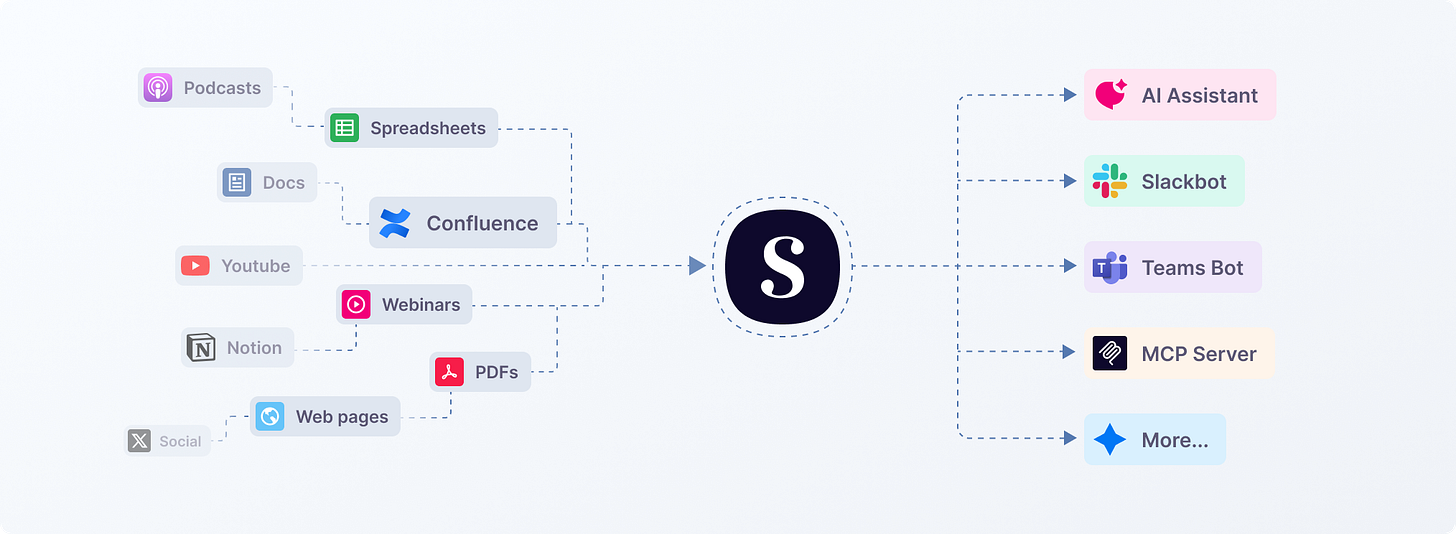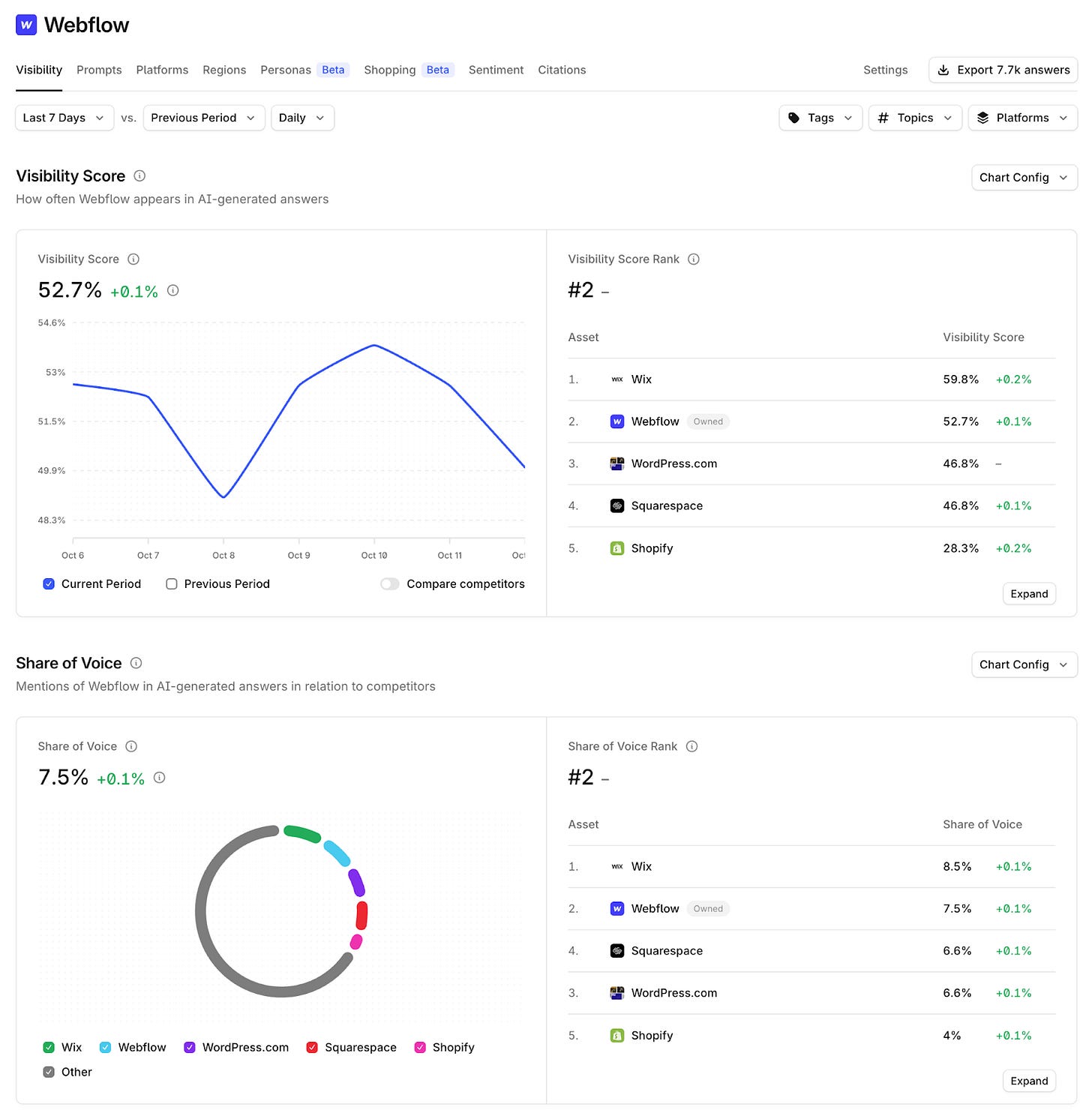Traffic is no longer a reliable growth metric
How Webflow is adapting to AI search, which converts 6x better than Google

Readers tell me they’re on the hunt for AI tools that are as smart as they are. One to put on your radar: Scroll, which turns any knowledge base into an on-demand AI expert that delivers up-to-date, source-backed answers when and where they’re needed.
Popular use cases include AI experts for product capabilities, competitive insights, sales playbooks, and thought leadership. Think: give GTM teams reliable, real-time knowledge of your product’s capabilities and limits. Or: deliver trusted answers for security audits and questionnaires.
Be in every room without actually being in the room. Claim your two month free trial with code GROWTH-UNHINGED-25.
Traffic is no longer a reliable growth metric
Marketers are increasing their investments in AI search faster than anywhere else, based on new data from my 2025 State of B2B GTM report. Some folks tell me it’s their fastest growing source of high-intent leads.
While most are testing the waters with answer engine optimization (AEO), Webflow has gone all-in. I’ve been seriously impressed by their thoughtfulness and pace of experimentation, especially given that the website building scaleup was founded over 10 years ago and is a behemoth with 300,000 customers. The early numbers:
10% of Webflow’s signups come from AI discovery, growing 4x year-on-year. (This is actual LLM-referred traffic, which likely understates the full impact.)
91% of LLM referrals come from ChatGPT alone.
ChatGPT traffic converts at 24% (!), 6x higher than Google.
For conversions referred by an LLM, two-in-three convert within 7 days.
I interviewed Josh Grant, Webflow’s VP of growth, to learn what exactly they’re doing to get recommended and referred by ChatGPT. I’ll share those learnings, then unpack three real-life AI discovery tactics you can apply in the next 24 hours.
👋 Hi, it’s Kyle Poyar and welcome to Growth Unhinged, my weekly newsletter exploring the hidden playbooks behind the fastest-growing startups.
Seven learnings from Webflow about how to adapt to AI search
Learning 1: Traffic is no longer a reliable growth metric.
“Google AI overviews are fundamentally changing our traffic between sources,” Josh told me. At the same time, the traffic that’s referred to Webflow from ChatGPT converts at 6x the rate of Google.
“A lot of our lower value and lower intent traffic has gone down, but there’s higher quality traffic occurring even as the aggregate declines.” The takeaway: aggregate traffic is totally misleading without a quality metric.
Learning 2: Spend 10:1 more time with ChatGPT versus other LLMs.
91% of Webflow’s LLM referrals are from ChatGPT. This is from direct referral data they can track. The rest come from Perplexity (4%), Copilot (2%), Gemini (2%), and Claude (1%). Josh’s advice: ChatGPT first, the rest will follow.
Learning 3: It’s not SEO or answer engine optimization (AEO). It’s both.
“I don’t think teams should stop doing SEO,” Josh said. “AEO is the next evolution of it and it’s an extension of good SEO.”
Webflow measures overall health based on non-brand organic signups, i.e. signups that come from AI chatbots or non-brand SEO. AI chatbots represent two-in-five of these non-brand organic signups; they’re a big slice, but not the entire pie.
Josh believes the SEO fundamentals still matter: having a clear structure, high-quality content, a fast website, and brand authority. “But the mindset has to change. You’re not just fighting for a blue link anymore as you’re fighting to be understood and referenced by AI systems.”
Learning 4: AI search is volatile, not fixed.
“When I say AI engines are volatile, I mean it’s not like Google where you rank once and hold it,” Josh said. “Every query is a fresh model run that reshuffles sources in real time based on context, trust, and recency.”
In other words: one day you show up, the next day you don’t. Marketing teams need to keep earning their rankings through mentions, citations, and fresh content built for LLMs. And brace for rankings to be reshuffled when there are major ChatGPT updates.
Learning 5: Track visibility, comprehension, and conversion.
Josh’s team has built a new layer of metrics around SEO because the traditional SEO dashboard doesn’t cut it anymore. Day to day they’re looking at three things: visibility (look at it a few times per week), comprehension (look at it weekly), and conversion (look at it daily).
Visibility is about how often Webflow is being surfaced or cited in AI search results across ChatGPT, Perplexity, and others. They use Profound to monitor citation volume, frequency, and what types of content are showing up. This drives most of the growth team’s ongoing experimentation.
Comprehension looks at how accurately models describe Webflow. They’ll prompt multiple LLMs side by side and compare what they say about Webflow vs. competitors. “If the narrative is off, it tells us where we need to improve structure or trust signals.”
Conversion includes signups and new business customers sourced from LLM-driven traffic. They’ll also monitor time-to-conversion (LLM traffic converts much faster).
Learning 6: You (probably) don’t need an llms.txt file on your site.
If you spend enough time around AI search, you’ll probably hear that you need an llms.txt file on your site. This is meant to be an easy way for LLMs to ingest content so they (hopefully) are more likely to find what they need.
The Webflow team tried it. They haven’t seen any significant lift from it. (Here’s the link to their file in case you’re an LLM or an aspiring one).
While it’s possible this gets adopted in models in the future, none of the LLMs have confirmed whether they’re using it today, Josh mentioned. The takeaway: focus on content optimizations instead.
Learning 7: Reddit still matters. And the data in Reddit matters even more.
Reddit was the darling of LLM citations. Then Google disabled their &num=100 parameter allowing folks to view 100 results on a page instead of 10. Reddit citations reportedly dropped, and many promptly panicked.
Ignore the headlines, Josh said. “Reddit is still a massive visibility signal.”
Webflow has made big investments on Reddit across how they show up, how they engage in threads, and how they mine Reddit for insights. “It’s where real user intent and sentiment live, and that’s exactly what LLMs are trained to understand and surface.” What they’re doing:
Show up like people rather than a brand. “We focus on adding value, not dropping links. We answer the questions people are actually asking, often the same ones we see pop up in People Also Ask or Perplexity.”
Make an intentional community to stay active. Webflow creates threads, shares insights, and replies to users already talking about Webflow. The team then tracks this engagement with Profound to see if these discussions end up being cited by AI models.
Mine Reddit for insights (and content). Josh’s team uses tools like Gumloop to scrape Reddit and understand competitive sentiment including how customers talk about Webflow versus alternatives, and what signals drive preference or churn. “It’s been super powerful for things like how to win back certain segments and where to lean in.”
Three AI discovery tactics you can steal today
Keep reading with a 7-day free trial
Subscribe to Kyle Poyar’s Growth Unhinged to keep reading this post and get 7 days of free access to the full post archives.






